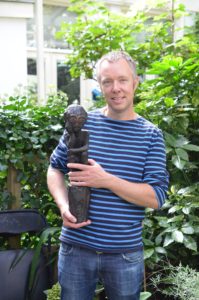Folkert de Jong
I’m scared that I’ll get completely carried away buying tribal art, the threshold is low and the excitement high!!
Folkert de Jong is a visual artist. He was introduced to special objects at an early age because his parents used to collect them. The beauty of nature and handicraft was very important to them, which is why their house was full of items collected from nature, such as stones, driftwood, but also wood carvings and ceramics. His childhood memories are full of stories his parents would tell relating to each object. That certainly influenced his decision to surround himself with items that have stories attached to them. He gains positive energy from objects with a message or a meaning.
Folkert collects all sorts of things: tribal art from Borneo, Papua and Toraja, but also ceramics from Peru and two wonderful wooden sculptures from the Philippines. Recently, he started building up a collection of succulents. However, it is rather remarkable that, despite being a contemporary artist, his home mainly contains ancient art. Together with his wife, Delphine Courtillot, who is also a visual artist, he prefers old objects. “It’s as if via these objects, the past is still working its way through to the present and giving us a sense of deceleration in these rapidly changing times”.
History is a theme in his work and in what he collects. For him, connecting with the past via collectables is a type of slowing down. “Through that, you realise that you need to live intensely with people and objects that are a positive force for you.” The more items he owns, the more he thinks about death. Through his collection, he attempts to keep a grip on the time that is slowly slipping out of his hands. This is why he is always buying new things, to remove the pressure of time and to be able to enjoy his life on this planet.
The objects he surrounds himself with influence his work. If he wakes up in the morning and sees a pair of wonderful deities from Indonesia, he thinks: this is a good day to make beautiful and powerful works of art. The objects are a type of battery for him. He is very attached to a small statue of a crouching human figure originating from the Ifugao from the Philippines. The animist statue reminds him of Rodin’s The Thinker. To Folkert, it represents the universal man who is contemplating his fate. Folkert enjoys looking at objects that are animist because they connect him with something he is distanced from in his daily life: the unity between humankind and nature, objects and religion.
He really likes seeing how passionately collectors are able to talk about their art, as if it is their religion; something that gives depth and meaning to the relativity of their own existence. He also sees this with collectors of his own work.
He buys from online auctions, but he prefers to buy from galleries so that he can get information from the owner. Another bonus is that you can see and feel the object before you buy it. He has visited the Tribal Art Fair a couple of times and thinks it’s a great fair. It’s approachable and everyone is friendly. He also enjoys seeing who’s having a look around and which special and beautiful objects are for sale. But he struggles to look around feeling relaxed. He doesn’t see himself as a specialist. As such, he struggles a bit when it comes to estimating the financial and cultural value of an object, because he thinks he doesn’t know enough about it. That makes it uncomfortable for him to ask questions. He also says, “I’m scared that I’ll get completely carried away buying tribal art, the threshold is low and the excitement high!!
Folkert de Jong
Ik ben bang dat ik mij helemaal te buiten ga aan het kopen van tribale kunst, de drempel is laag en de opwinding hoog!!
Folkert de Jong is beeldend kunstenaar. Hij kwam al vroeg met bijzondere voorwerpen in aanraking die door zijn ouders verzameld werden. De schoonheid van de natuur en ambacht was voor hen erg belangrijk en daardoor stond het huis vol met gevonden dingen uit de natuur. Zoals stenen, stukken drijfhout maar ook houtsnijwerk en keramiek. De herinneringen uit zijn jeugd zitten vol met verhalen die zijn ouders hadden bij ieder voorwerp. Dat heeft hem zeker beïnvloedt om zichzelf te omringen met voorwerpen die verhalen in zich meedragen. Hij krijgt positieve energie van objecten met een boodschap of een bedoeling. Folkert verzamelt van alles en nog wat. Tribale kunst uit Borneo, Papoea, en Toraja. Maar ook keramiek uit Peru en twee geweldige houten beelden uit de Filipijnen. Recentelijk is hij begonnen met het aanleggen van een collectie succulenten (vetplanten en cacti.). Het is wel opmerkelijk dat hij als hedendaagse kunstenaar eigenlijk vooral oude kunst in huis heeft staan. Samen met zijn vrouw, Delphine Courtillot, ook beeldend kunstenaar, houdt hij meer van oude voorwerpen. “Het lijkt alsof via deze dingen het verleden nog doorwerkt in het heden, en ons een gevoel van vertraging geeft in deze snel veranderende tijd”
Geschiedenis is een thema in zijn werk en ook in wat hij verzamelt. Verbinden met het verleden via verzamelobjecten is voor hem een soort vertragen. “Je beseft je erdoor dat je intens moet leven met mensen en voorwerpen die je positieve kracht geven”. Hoe meer spullen hij bezit, hoe meer hij nadenkt over de dood. Via zijn verzameling probeert hij grip te houden op de tijd die langzaam uit zijn handen weg glijdt. Daardoor koopt hij ook steeds nieuwe dingen, om het touw van de tijd langer te maken en te kunnen genieten van zijn leven op deze planeet.
De objecten waar hij zich mee omringt hebben invloed op zijn werk. Als hij
’s ochtends wakker wordt en een paar prachtige godenbeelden uit Indonesië ziet, dan denkt hij: dit is een goede dag om mooie en krachtige kunstwerken te maken. De objecten zijn voor hem een soort batterijen. Heel erg gehecht is hij aan een klein beeld van een gehurkt mensfiguur afkomstig van de Ifugao uit de Filipijnen. Het animistische beeldje doet hem denken aan De Denker van Rodin. En het verbeeldt voor hem de universele mens die nadenkt over zijn lot. Folkert kijkt graag naar voorwerpen die animistisch zijn omdat zij hem verbinden met iets waar hij in het dagelijks leven ver van af staat: de eenheid tussen mens en natuur, gebruiksvoorwerpen en religie. Hij vindt het echt mooi om te zien hoe gepassioneerd verzamelaars over kunst kunnen praten. Alsof het hun religie is, iets wat diepgang en zingeving geeft aan de betrekkelijkheid van hun eigen bestaan. Dit ziet hij ook bij verzamelaars van zijn eigen werk.
Hij koopt bij online veilingen maar het liefst koopt hij in galerieën omdat hij daar informatie krijgt van de verkoper. En daar kan je het voorwerp zien en voelen voordat je het koopt. Hij heeft een paar keer de Tribal Art Fair bezocht en hij vindt het een hele leuke beurs. Het is laagdrempelig en iedereen is vriendelijk. Ook vindt hij het leuk om te zien wie er rondkijken en wat voor bijzondere en mooie dingen er te koop zijn. Maar het blijft voor hem best moeilijk om ontspannen rond te kijken. Hij ziet zichzelf niet als specialist. Zo kan hij, omdat hij naar zijn idee er te weinig vanaf weet, de financiële en culturele waarde van iets moeilijk inschatten. Dat maakt het voor hem ongemakkelijk om vragen te stellen. Bovendien zegt hij “Ik ben bang dat ik mij helemaal te buiten ga aan het kopen van tribale kunst, de drempel is laag en de opwinding hoog”!!

